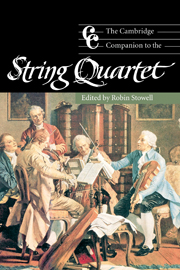Book contents
- Frontmatter
- Part I Social changes and organological developments
- Part II Celebrated ensembles
- Part III Playing string quartets
- Part IV The string quartet repertory
- 8 The origins of the quartet
- 9 Haydn, Mozart and their contemporaries
- 10 Beethoven and the Viennese legacy
- 11 The Austro-Germanic quartet tradition in the nineteenth century
- 12 Traditional and progressive nineteenth-century trends: France, Italy, Great Britain and America
- 13 Nineteenth-century national traditions and the string quartet
- 14 The string quartet in the twentieth century
- 15 The string quartet as a foundation for larger ensembles
- Notes
- Select bibliography
- Index
14 - The string quartet in the twentieth century
from Part IV - The string quartet repertory
Published online by Cambridge University Press: 28 September 2011
- Frontmatter
- Part I Social changes and organological developments
- Part II Celebrated ensembles
- Part III Playing string quartets
- Part IV The string quartet repertory
- 8 The origins of the quartet
- 9 Haydn, Mozart and their contemporaries
- 10 Beethoven and the Viennese legacy
- 11 The Austro-Germanic quartet tradition in the nineteenth century
- 12 Traditional and progressive nineteenth-century trends: France, Italy, Great Britain and America
- 13 Nineteenth-century national traditions and the string quartet
- 14 The string quartet in the twentieth century
- 15 The string quartet as a foundation for larger ensembles
- Notes
- Select bibliography
- Index
Summary
Although the string quartet did not regain the privileged position it enjoyed during the Classical period, many twentieth-century composers from many different cultural backgrounds and stylistic positions looked to the genre as a context suitable for their most intimate thoughts. Throughout the century the string quartet was often viewed not only as a medium conducive to experimentation and formal innovation, but also for its positive re-engagement with tradition; this double focus was symptomatic of the multifarious nature of modernism, an ‘ism’ which encapsulated the defining aesthetic trends of the early decades of the century. This sense of experimentation and innovation often led to an expansion of playing techniques, an increase in the expressive parameters of the music and departures from the standard four-movement pattern of the Classical quartet. However, despite its use as a vehicle for change, the string quartet continued to provide a generic framework which reflected the inherited traditions and conventions as accumulated through the history and stylistic developments of the genre, even if in some cases it was only to construct a point for new departure. This relationship between tradition and innovation, a relationship which was at times oppositional, at others interactive, will come to be seen as a defining reference point for a generalised understanding of the string quartet repertory of the twentieth century. It will become pertinent through regional/national surveys of some of the main composers and works in the medium. Such surveys are not necessarily intended always to suggest national style groupings; rather they are used merely as a convenient and accessible format through which the principal works can be presented.
- Type
- Chapter
- Information
- The Cambridge Companion to the String Quartet , pp. 288 - 309Publisher: Cambridge University PressPrint publication year: 2003
- 1
- Cited by

